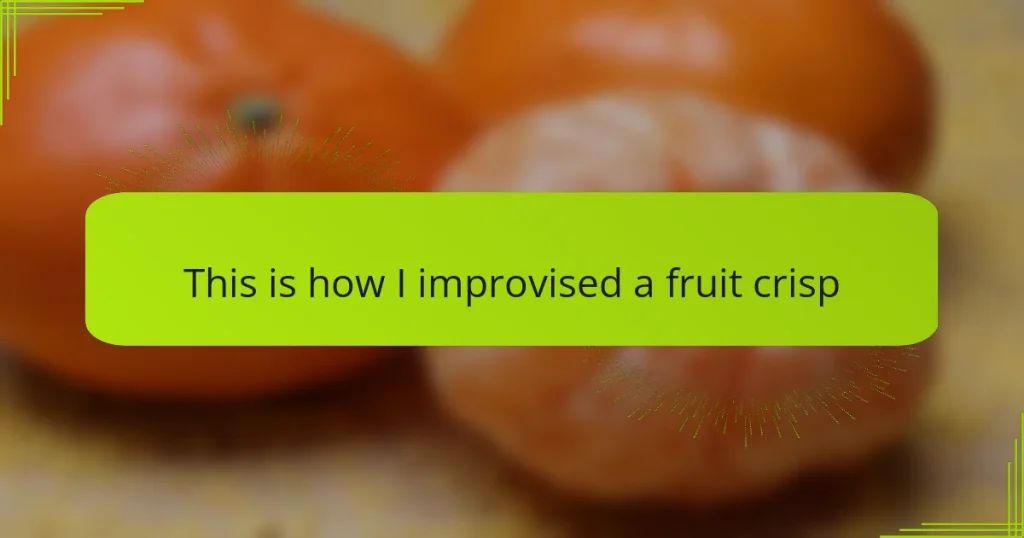Key takeaways
- Fruit crisps combine tender fruit with a crunchy topping, offering a comforting dessert that’s easy to prepare and personalize.
- Essential ingredients include fruit, sugar, oats, flour, and butter, with room for seasonal adaptations and flavor enhancements.
- Choosing the right fruit and proper preparation techniques, such as even sizing and careful baking, are crucial for achieving the desired texture and flavor.
- Allowing crisps to cool before serving and storing them properly helps maintain their delicious crunch and enhances flavors over time.
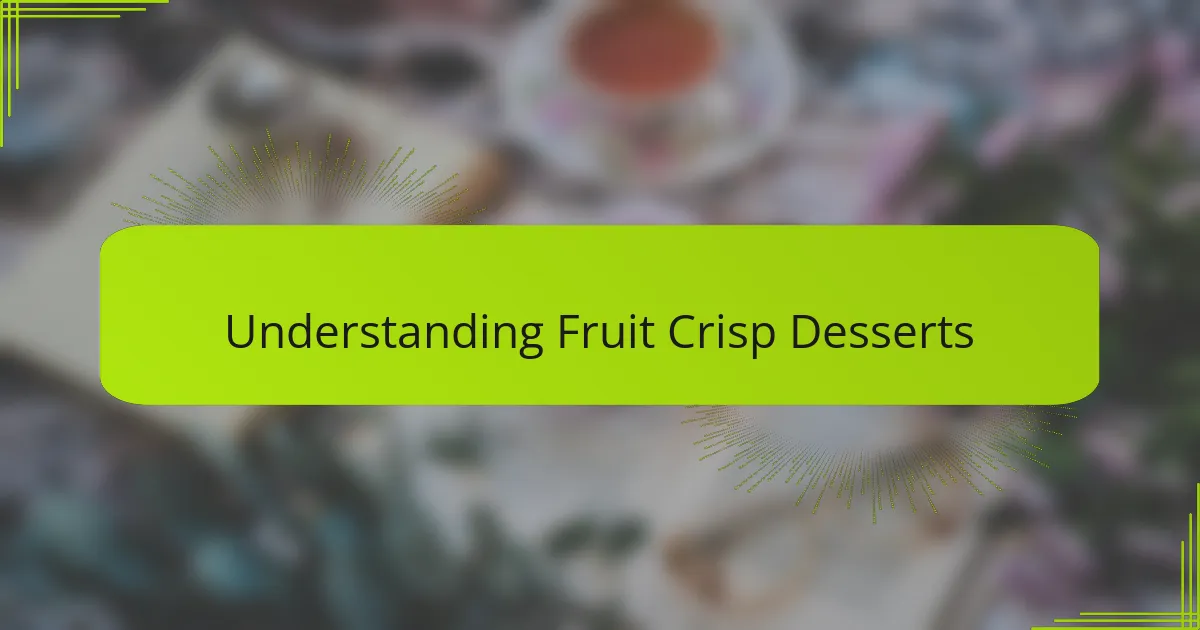
Understanding Fruit Crisp Desserts
Fruit crisp desserts have always struck me as the perfect blend of simplicity and comfort. At their core, they’re about marrying tender, juicy fruit with a crunchy, buttery topping that contrasts beautifully in texture. Have you noticed how that satisfying crunch can turn a humble fruit dish into something downright memorable?
What I find fascinating is how forgiving and adaptable crisps can be. Whether you’re working with apples, berries, or stone fruits, the basic concept remains the same—fruit filling beneath a crumbly mixture often made of oats, flour, sugar, and butter. This versatility is what makes crisps so approachable, especially when you want to experiment without the pressure of precise measurements or fancy techniques.
Sometimes, I wonder why fruit crisps don’t get enough credit compared to other desserts like pies or cobblers. Maybe it’s their rustic charm — easy to make but endlessly comforting. When I bite into a warm fruit crisp, it reminds me of cozy afternoons and simple joy, which, to me, is the heart of any great dessert.
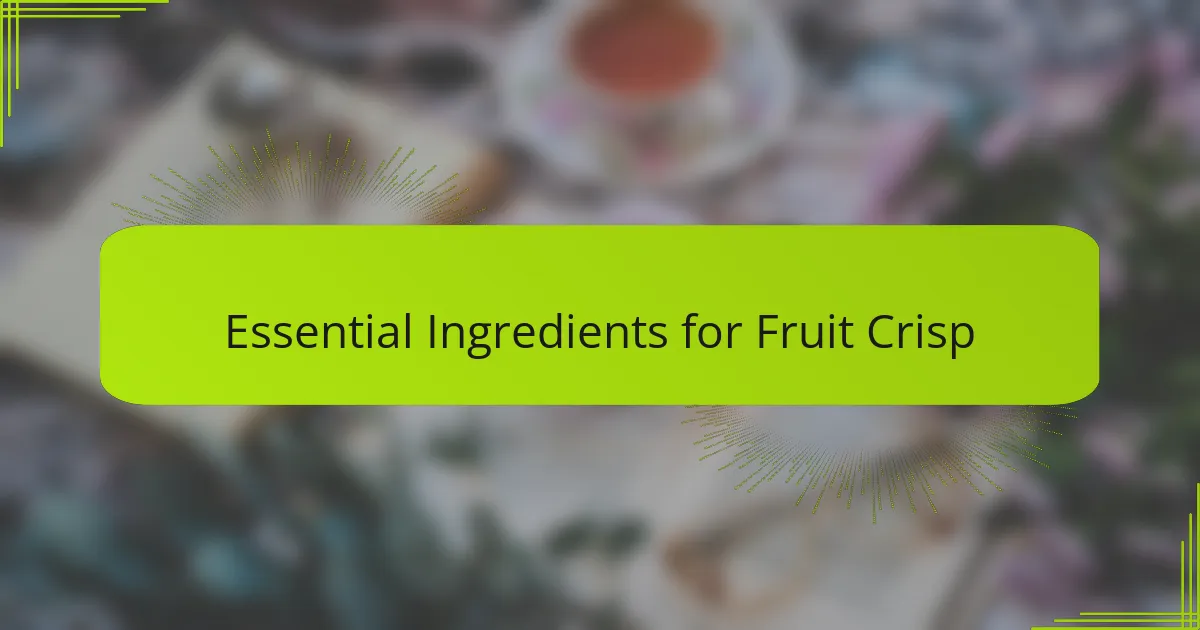
Essential Ingredients for Fruit Crisp
When I first started making fruit crisp, I quickly realized the importance of having a solid foundation: good fruit, sugar, and a crispy topping made from oats, flour, butter, and brown sugar. Without those basics, you risk losing that satisfying contrast between tender and crunchy that makes a crisp so comforting. I always think about how each ingredient plays its part, like the oats adding that rustic chewiness and the butter bringing richness to every bite.
Have you ever wondered why some crisps come out soggy or lacking flavor? For me, it’s all about balancing the sweetness and textures. The fruit needs just enough sugar to highlight its natural juices without turning into syrup, while the topping should be buttery and golden, giving you that perfect crunch. That interplay is what turns a simple dessert into something memorable.
One thing I absolutely swear by is being flexible with the ingredients depending on the season or what I have on hand. Sometimes I swap regular flour for almond flour for extra nuttiness or add a pinch of cinnamon to the mix to deepen the warmth. These tweaks keep the fruit crisp interesting, yet the core essentials—fruit, sugar, oats, flour, and butter—always remain my go-to starting point.

Choosing the Best Fruits
Choosing the best fruits is where the magic really begins for me. I tend to pick fruits that feel ripe but still hold their shape when baked—nothing mushy or overly soft. Have you ever used underripe apples or overripe berries? The texture can make or break that tender, juicy filling I crave.
I often lean towards a mix of sweet and tart fruits to keep things interesting. For example, combining Granny Smith apples with fresh blueberries adds layers of flavor and balance. It’s like a little flavor dance happening in the oven, which I find really satisfying.
Sometimes, I experiment with whatever fruits are in season or what’s sitting in my fridge. Last summer, I tried peaches and plums together, and the result was unexpectedly delicious. That’s the beauty of fruit crisps—they let you follow your taste buds and creativity without strict rules.
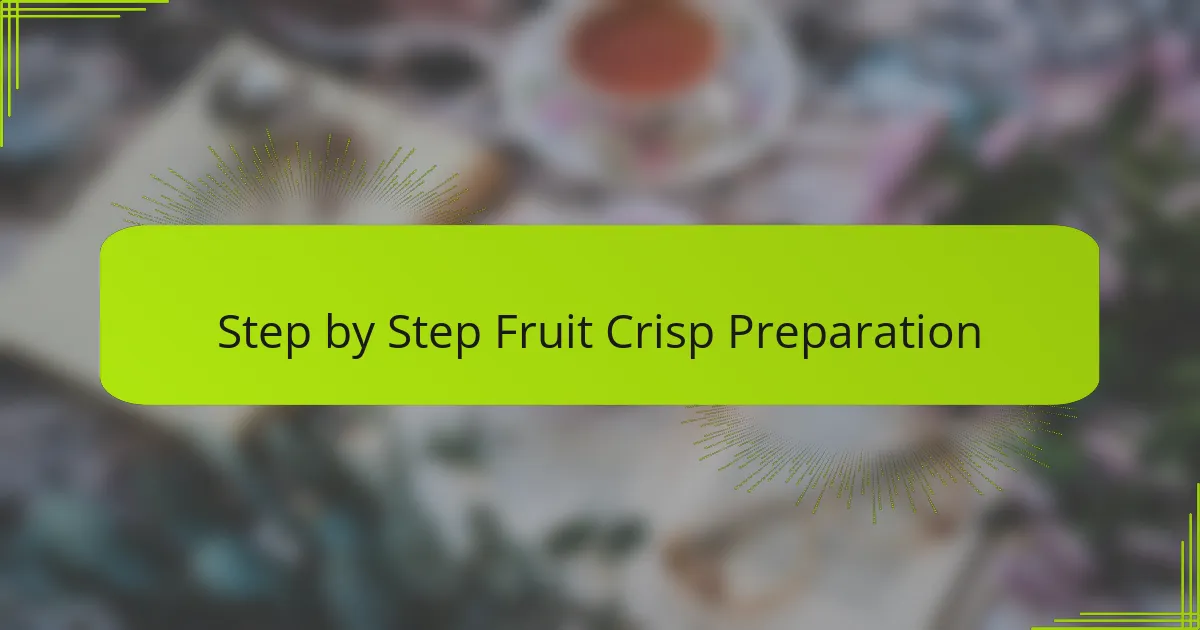
Step by Step Fruit Crisp Preparation
When I start preparing a fruit crisp, I always begin by prepping the fruit—washing, peeling if necessary, and cutting into even pieces. Have you noticed how important even sizing is to make sure all the fruit cooks uniformly? From there, I toss the fruit with just enough sugar and a pinch of cinnamon to coax out the natural juices without making it too wet.
Next comes the topping, which I find to be the heart of the crisp. I mix oats, flour, brown sugar, and cold butter, then use my fingers to crumble it all together until it resembles coarse crumbs. There’s something oddly satisfying about this part—like creating little pockets of buttery crunch that will bake up golden and irresistible.
Finally, I spread the fruit mixture in a baking dish and top it generously with my crumble. Baking at the right temperature is key—I’ve learned 350°F works best to get the topping crisp while the fruit bubbles gently underneath. Waiting for that smell to fill the kitchen? That’s my favorite part, knowing a warm, comforting dessert is minutes away.
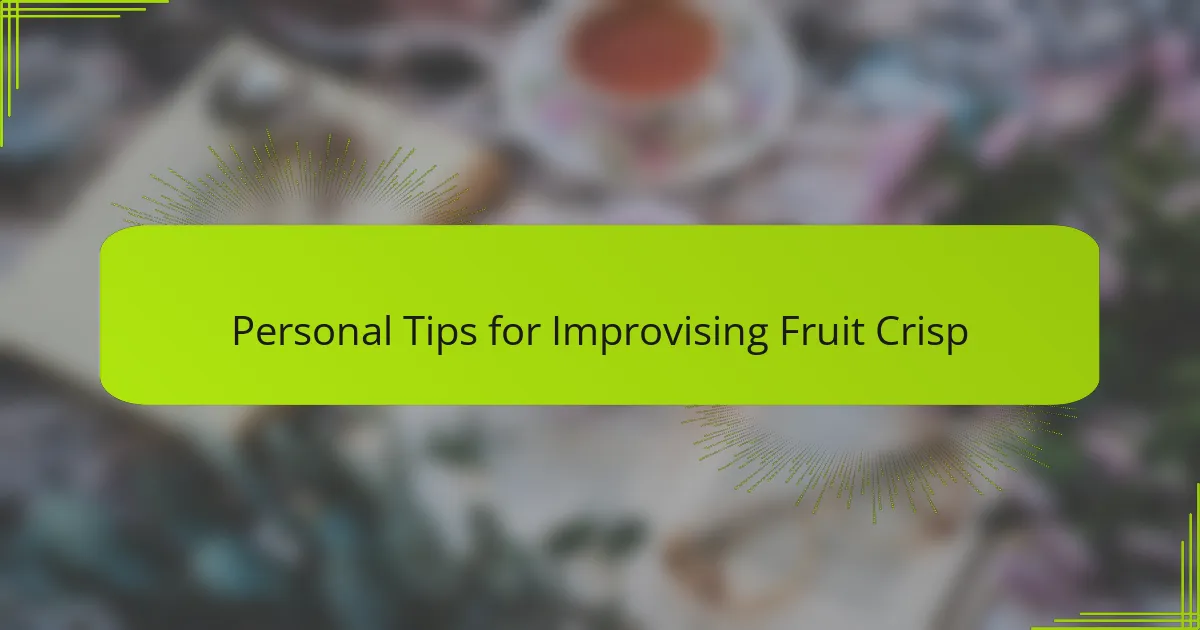
Personal Tips for Improvising Fruit Crisp
Whenever I’m improvising a fruit crisp, I like to trust my instincts rather than strict recipes. Have you ever just tasted your fruit mixture first to decide if it needs more sweetness or a touch of spice? That little moment of tasting and adjusting has saved many of my crisps from being too bland or overly sugary.
Another trick I’ve leaned on over time is playing with texture contrasts. Sometimes, I add chopped nuts or even a handful of shredded coconut to the topping for an extra layer of crunch. It might seem unconventional, but these personal touches make each crisp uniquely mine and always surprise my family in the best way.
And here’s something I learned the hard way: keep an eye on the baking time. A few minutes too long means a dried-out topping, but just a bit too short leaves it soggy. I actually set my timer earlier than the recipe suggests and check in frequently—it’s a little dance, but it’s worth it for that perfect golden crisp. Have you ever found that balance? It’s such a satisfying feeling when you do.

Common Mistakes to Avoid
One mistake that’s tripped me up more than once is using too much fruit juice or sugar in the filling. I remember one crisp I made where the fruit released so much liquid that the topping never really got crisp—it just soaked up all that moisture and turned mushy. Have you ever bitten into what was supposed to be a crunchy topping only to find it soggy? It’s disappointing, but dialing back the liquid or adding a bit of thickener like cornstarch makes all the difference.
Another pitfall I’ve noticed is rushing through the topping preparation. Sometimes, when I’m in a hurry, I don’t mix the butter evenly, and the crumble bakes unevenly—some parts get too crunchy while others stay doughy. Taking a moment to crumble the butter properly with my fingers, so it’s distributed in small, coarse clumps, gives the topping that perfect golden-brown texture I crave.
And then there’s the baking time—oh, the fine line between perfectly crisp and burnt. I once got so distracted I left my crisp in the oven a bit too long, resulting in a burnt edge that no sponge cake could save. Setting a timer and starting to check a few minutes before the recipe’s suggested time has become my best habit. It’s a small step that keeps the topping crisp and the fruit filling just bubbling, exactly how I like it.
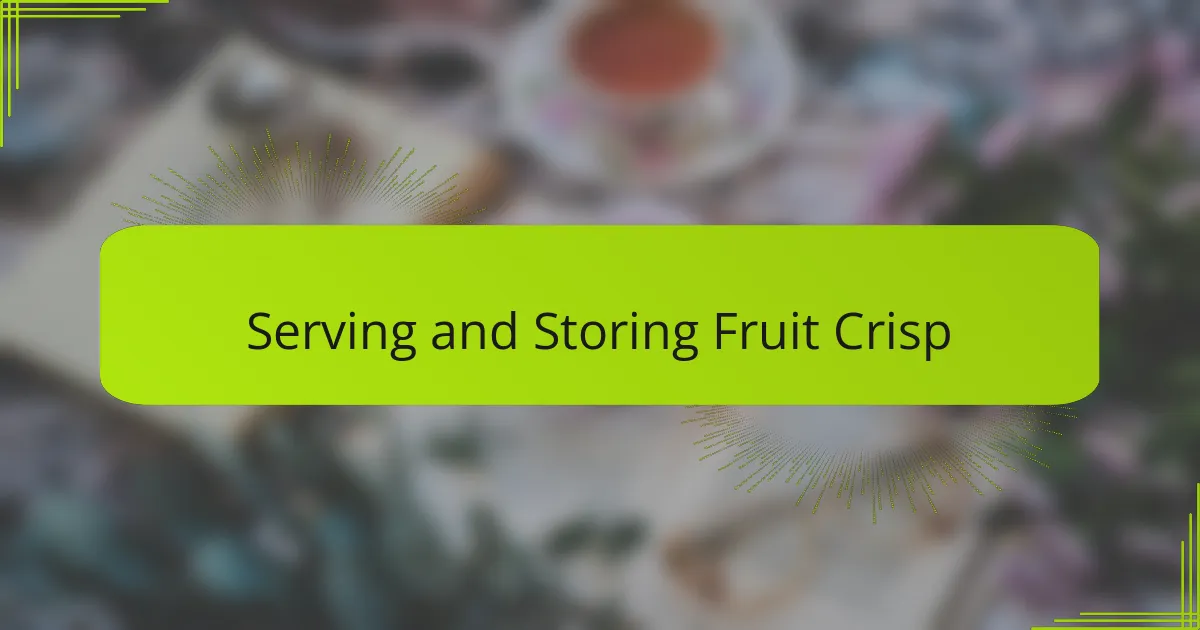
Serving and Storing Fruit Crisp
When I serve fruit crisp, I usually like to let it cool just a bit before digging in—there’s something about that warm, gently bubbling fruit paired with the crunchy topping that feels like a hug in dessert form. Have you noticed how a scoop of vanilla ice cream or a dollop of whipped cream can elevate the experience? Those cold, creamy accents melt beautifully against the crisp’s warmth, making every bite a little celebration.
Storing leftover fruit crisp has taught me the value of patience. I tend to cover it tightly and pop it in the fridge, knowing it actually tastes better the next day when the flavors have had time to meld. Ever reheated a crisp and found the topping a bit less crunchy? I’ve found that giving it a quick warm-up in the oven (instead of the microwave) revives that lovely crunch without sacrificing the tender fruit.
One thing I learned the hard way is not to store fruit crisp uncovered—moisture quickly seeps in, turning that precious crisp topping soggy. It’s easy to forget, but a proper airtight container keeps the textures just right for a couple of days. Have you had the disappointment of soggy crumbs? Avoiding that makes all the difference when you’re ready for another slice of comfort.
